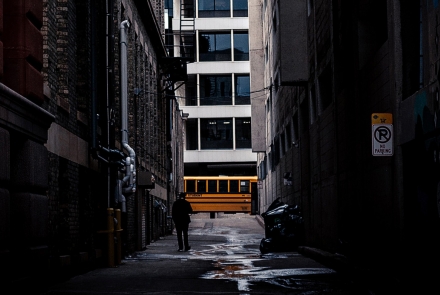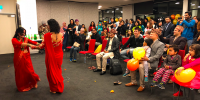
PHOTO: Alex Simpson on Unsplash
Building tolerant and vital cities
Multiculturalism is an increasingly contested term in Australia. These debates often involve declaring its ‘costs’ and ‘benefits’, but usually thrive absent of evidence. However, new research on urban policy in Central Dandenong can shed light on this, Helen Sullivan, Brendan Gleeson and Hayley Henderson write.
Research in one of the country’s most diverse neighbourhoods, Central Dandenong, Melbourne, has examined urban revitalisation policy, and identified specific aspects of planned revitalisation that reinforce cultural pluralism.
By supporting difference and tolerance without imposing assimilation, the Dandenong case shows the importance of cultural pluralism to a sensible urban development policy, and potentially paves the way for other cities to follow suit.
The research – funded by the Economic and Social Research Council – suggested that cultural pluralism is an important dimension to be considered when embarking on planned revitalisation in Australian urban centres.
According to one senior local government representative, the revitalisation process was “obviously going to build off the success of cultural diversity.” For example, community engagement strategies were planned to support diversity and a culturally sensitive approach to some aspects of revitalisation was adopted, for example in the Dandenong Market upgrade or the designation of the Afghan Bazaar.
Support for cultural pluralism is bipartisan, going beyond the specific program of revitalisation to other areas of public policy work locally. For example, in designing specific home-based aged care packages for distinct cultural communities, or through funding the Interfaith Network of Greater Dandenong, governments have reinforced cultural pluralism in a positive way.
It’s important to note that this general support for cultural pluralism in the revitalisation program has not been sufficient to tackle some problems. For example, trauma counselling for some former refugees or and asylum seekers is appreciably insufficient.
In addition, some residents mentioned experiences with racism and discrimination in accessing employment opportunities locally, indicating the need for continued efforts in this area too.
In terms of positive effects though, the research found a series of characteristics that create everyday encounters and lasting interactions between people.
In doing so, it showed that revitalisation could be used to build intercultural understanding and a sense of belonging in this highly diverse area, where 72 per cent of the population was born overseas, mostly from Afghanistan, India, Sri Lanka, China, and Pakistan.
One important characteristic is housing. Central Dandenong’s revitalisation experience demonstrates an increase in overall dwellings, and housing types that are more diverse compared to the rest of Greater Melbourne, allowing flexibility and affordability for residents.
The average cost of rent for residents in Central Dandenong has remained ‘affordable’ – below 30 per cent of household income. Access to public transport, grocery stores/market, social services, and local employment means the overall cost of living is affordable.
While currently still acceptable, rental affordability is declining in the area.
The average proportion of income spent on rent increased from 24 per cent in 2006 to 27.7 per cent in 2019. This reflects a city wide trend of increasing rental costs and locally reflects a process of gentrification.
For Central Dandenong, this presents a threat. Rising rental costs are pushing some families into crowded conditions or into neighbouring municipalities where there aren’t as many services. Maintaining affordable housing was not an aspect of the original Victorian Government’s strategy, a missed opportunity which has now fallen to the Council’s Housing Strategy.
Along with housing, the revitalisation process focused on revitalising the public realm. It provided an increasing number of spaces that offer opportunities for building familiarity and sociability among residents. These spaces are intermixed with other land uses, though are neither work nor home destinations.
They include a library, neighbourhood houses, a market, retail outlets, grocery stores, and coffee shops, universities, and TAFE facilities. There is also a Pop-up Park, civic square, a theatre, and cultural precincts. Multiple interviewees commented on an improved sense of safety for Culturally and Linguistically Diverse (CALD) women as a product of the revitalisation effort.
State and Local Governments also fund important local events, such as a Food and Wine Festival, or cultural and religious festivals. This too can serve to create opportunities for interaction within diverse communities.
Also crucial to revitalisation have been employment, education and training. More people are accessing training opportunities in technical or other further education institutions. Some 8.5 per cent of the Dandenong population were in education in 2011, compared to 11.5 per cent in 2016.
Multiple community-based organisations, including the library, church groups, and non-profit organisations offer English language classes as well as support in the search for employment, and this reflects the benefits of cultural pluralism in the revitalisation process.
While there are fewer opportunities in manufacturing the region than in the past, training supports residents living in Central Dandenong to find employment in growing industries like food retailing, health services, construction and residential care services.
Overall, unemployment in Dandenong remains high relative to the Melbourne and Australian contexts, though has been reduced from 15.3 per cent in 2001 to 13.4 per cent in 2016.
Despite many new opportunities precipitated by the revitalisation process, a decline in automotive manufacturing has been a significant structural challenge.
There are, however, shortcomings regarding employment and training. Many new opportunities are not responsive to cultural norms or lack participation from some groups. In 2016, engagement in employment, education, and training was lower for women compared to men born in Australia, and, as a percentage, the problem is even worse in CALD communities.
Despite these shortcomings, the case does show the many ways that cultural pluralism has been incorporated into revitalisation, as well as some of the challenges faced in further advancing CALD communities’ opportunities.
As explained in more detail in the full Research Briefing, Central Dandenong’s experience shows that an outlook for revitalisation policy with cultural pluralism at its core has many advantages. Potentially, an approach like this could be taken across the nation, and used to build more tolerant and vital multicultural communities.
Updated: 13 July 2024/Responsible Officer: Crawford Engagement/Page Contact: CAP Web Team













